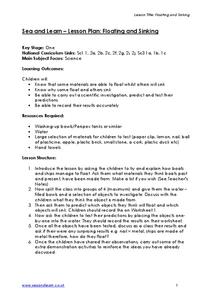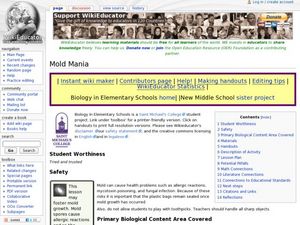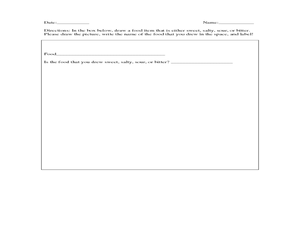American Chemical Society
Density of Water
We know solids have a density we can measure, but what about liquids? Lesson explores this concept and allows scholars to explore the relationship between volume and density. Graphing and analysis questions round out the activity.
American Chemical Society
Temperature Affects Density
Different substances can have different densities, but can the same substance have different densities? Lesson explores the effect of temperature on the density of water. Extension idea connects the concept of how melting ice in lakes...
Curated OER
Magnets 1: Magnetic Pick-ups
Students are introduced to the power of magnets. In groups, they look at different objects and make predictions on whether they believe they are magnetic or not. They test their predictions and share their results with the class.
Curated OER
Getting to Know Soil
Students make predictions and analyze soil. In this soil properties lesson, students make predictions about soil properties for various soil samples. Students examine the types of soils and record their observations. Students analyze...
Curated OER
Looking Back, Up and Ahead
Students explore how scientists have forecasted the 2002 Leonid meteor shower. They pose their own predictions for peak meteor rates per hour during the 2002 shower and compare their results with actual observed rates.
Curated OER
Germinate Bean Seeds
Students write the steps needed to germinate bean seeds, make predictions and observations and keep an experience journal and complete a chart.
Curated OER
Changing Rocks
Young scholars shake a box containing Plaster of Paris "rocks", gravel, and sand, to measure the effects of erosion. They work individually during this exercise. This task assesses students' abilities to make simple observations,...
Curated OER
Using a Thermometer
First graders use their senses to formulate questions and make predictions to determine what is in the "Wonder Bag". They hold pieces of ice and examine while listing descriptors on a chart and then take their own temperature using an...
Curated OER
Floating and Sinking
Students conduct experiments in which they investigate which materials float and which sink. They examine what qualities the materials that float have in common. They carry out a scientific investigation, predict, and test their...
Curated OER
Height of Bounce
Eighth graders determine the relationship between the height of bounce of a ping-pong ball and the height from which it was dropped. They are assessed on the ability to record and interpret data, graph data, make predictions, and make...
Curated OER
Electric Circuits
Fourth graders investigate complete and incomplete circuits. Using an electrical kit that includes a D-cell battery, wiring, and a flashlight bulb, they construct a complete electric circuit that will light the light bulb. Students...
Curated OER
Hot and Cold Colors
Students engage in an activity that will allow them to observe that hotter conditions can speed up changes in materials. They will predict whether food coloring disperses more quickly in hot, cold, or room temperature water, and then...
Curated OER
Oat Seed Lab: A Model Scientific Experiment
Young scholars investigate seed germination. In this lesson on scientific prediction, students conduct a scientific experiment using oat seeds.
Curated OER
Series and Parallel Circuits
Students study simple circuits. After a demonstration of parallel and serial circuit designs, students work in teams to predict the difference between two circuit designs. They build examples of two different circuits and test...
Curated OER
Your Weight on Other Planets
Students explore their weight on other planets. For this science lesson, students view a presentation about the other planets and complete a worksheet in which they make predictions about their weight on the moon and other planets.
Curated OER
Insulators And Conductors
High schoolers investigate the flow of electricity and how it effects different objects in the classroom as being classified as an insulator or conductor. They work in teams to test the conductivity of different classroom objects after...
Curated OER
Primary Biological Content Area Covered
Students use the scientific method to make predictions about mold growth. For this fungus lesson, students use worksheets to help them illustrate predictions and graph mold growth from white to wheat bread. Students first...
Curated OER
Flowers, Pods, and Seeds
Students gain an understanding of living organisms. the complete a plant growth data log to chart plant growth and to make observations, predictions, and personal reflections.
Curated OER
How Are The Properties of Covalent Compounds Influenced By Chemical Bonding?
Students work together to observe the bond lengths of single, double and triple bonds. They make their own predictions about the strength of the bonds and chemical reactions. They answer discussion questions to complete the lesson.
Curated OER
Move It!
Students explore the notion that simple devices can help us move objects when an understanding of forces is applied. They apply the design process, make predictions, draw sketches, make a model and evaluate their solution.
Curated OER
5E Magnets
Fourth graders, when working with magnets, make a prediction about what will happen if you put two ring magnets on an upright pencil, with 100% accuracy. They also experiment with magnets on poles to see which one pushes the other one away.
Curated OER
Mapping Lab and Lead Poisoning
Learners are introduced to GIS and its uses. They make predictions before viewing the actual lead poisoning cases by location of Dade County. Pupils use actual Miami-Dade County spatial data to explore basic principals. Students
Curated OER
Why Oil and Water Don't Mix
Second graders explore why oil and water do not mix. They make and record their predictions and observe the experiment in which cooking oil is mixed with a glass of water. Students discuss why they think the oil and water did not mix and...
Curated OER
Terrific Taste Buds
Learners explore descriptive writing by eating food in class. In this descriptive word lesson, students assess different foods in class such as jelly beans and utilize their vocabulary to describe the taste. Learners read the story...

























